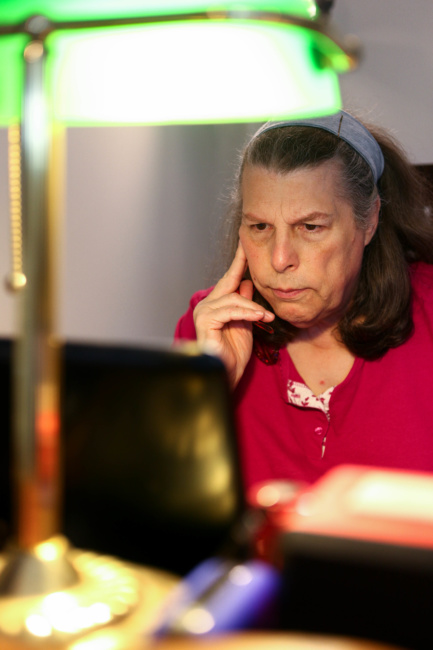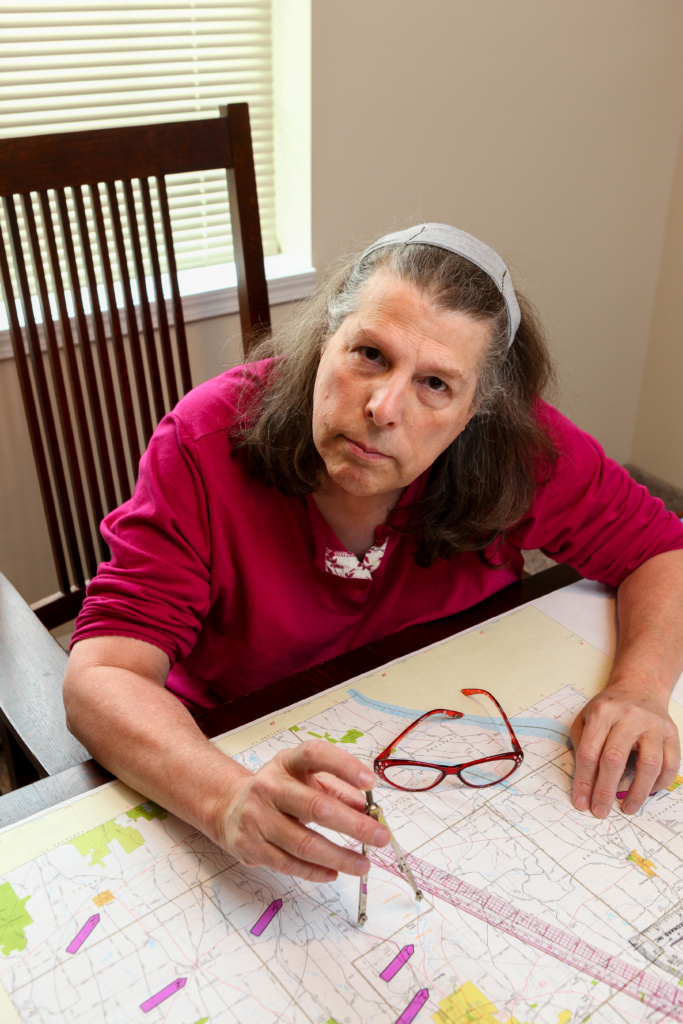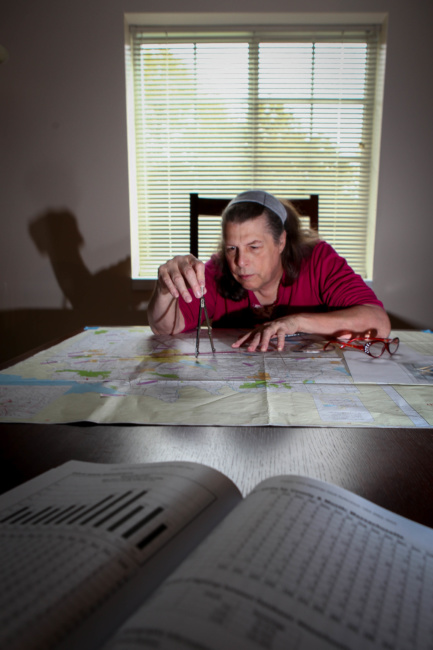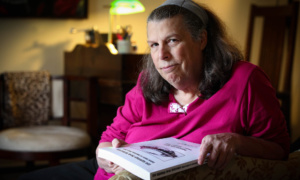
Are we alone in the universe? According to UFO researcher and columnist Cheryl Costa, the answer is an emphatic no. And her book, UFO Sightings Desk Reference: United States of America 2001-2015 (paperback, $39.95), released on March 24, has the statistics to back up that claim.
Costa and her wife, Linda Miller Costa, co-authored the 359-page amalgam of bar graphs and Excel sheets over a 16-month period of incessant number crunching. The book encompasses data from all 50 states from 2001 to 2015, which includes the number of sightings by month and year broken down by state and county. Shapes of the UFOs are also prominently featured.

Cheryl Costa in her study room. Michael Davis Photo
Due to her book’s groundbreaking subject matter, Costa has garnered national media attention from radio stations, science magazines, and even The New York Times.
The task of gathering data from privately funded and civilian-run organizations was tedious, yet Costa was determined to release that information in a way that she said has never been done before.
“This was the compelling notion: Let’s publish the numbers,” Costa said. “Let’s show people just how big this is. And we suspected it was really big.”
Costa officially retired from the work force in February after nearly 10 years in the Air Force and the Navy as an electronic surveillance technician, more than 30 years at Lockheed Martin as a computer security analyst, and several other short-lived jobs. She now spends her time furthering her research on UFOs and writing a well-trafficked column on the Syracuse New Times website called New York Skies.
Since starting the column in 2012, Costa has spoken at numerous symposiums around the country. Following the release of her book, more doors have been opened to speaking opportunities than ever before.
“We did one in Erie, Pa., and we had an audience there from New York, Pennsylvania and Ohio,” Costa said. “So I shared charts with them for their individual states. At these conventions I talk to everybody about everything.”
Costa is set to speak at the 2018 International UFO Congress in Arizona, which takes place Feb. 14 to 18. The event is the largest UFO conference in the nation, boasting 3,000 to 5,000 attendees per day each year.
Closer to home, Costa will speak at the Center for the Arts, 72 S. Main St., Homer, on Thursday, Oct. 26, 7 p.m. At the free event, she plans to take a break from discussing more recent UFO sightings to instead discuss experiences from the 18th, 19th, and 20th centuries.
What first got you interested in UFOs?
I saw my first one when I was about 12. In fact, the whole family saw it. We were coming back from a relative’s house, and we saw a big, silvery sphere parked out in a clear, blue sky in a late August afternoon. It was about a week before school started. My mother had my father pull the car over and we sat there for 15 to 20 minutes watching this thing. It was about the size of your fingernail out there in the sky.
My mother explained it could be a lot of things. It might be people from another planet. That got a conversation going with my mother and I over time, and we started getting books from the library and reading stuff with each other. And that was about as far as it went.
I had a few other sighting experiences in my early 20s. I’ve always just been very well read on the topic.
In November 2012, I saw a sidebar story on CNN.com. It said, “UFOs have been declining since the 1980s. Perhaps they were always just an urban legend.” And that didn’t feel right. So I went out to the Mutual UFO Network website for the first time in my life, and I looked up numbers for a couple of years in the late-1980s right up through about 2000. And the chart went up like a rocket. And I thought to myself, “What memo didn’t the UFOs get?”
That’s what got me going on the idea of, “Maybe we should start reporting these things.” So I pitched it to a couple of editors at different places, and finally I came over and talked to (former Syracuse New Times editor-in-chief) Larry Dietrich, and he was intrigued because I was going to pretty much tell New York state stories for the most part. That’s how we really got deep into it. It’s been five years.
Where did you learn so much about the topic of UFOs?
In 1990 I was recuperating from a medical illness for a time, and I was between apartments. A gentleman I knew at that time, he was taking care of his father who had cancer at another residence. He said, “Hey, if you feed my cat, you can stay at my house.” So I did. And he had first editions on everything that had been written up until that point on UFOs.
So for the few months that I was there recuperating, I read about everything he had. Like I said, I was very well read but didn’t want to follow it. It had a stigma to it. But I think the (article on CNN’s website) in 2012 spoke to me from the standpoint of misinformation. And that’s been talked about a lot over the years.
For over 70 years, there’s been this policy of denial and ridicule. So what does a lawyer do when he or she has an eyewitness to something? They do everything to discredit the witness. So they have this whole thing out there in the public mindset: “Oh, the people who report UFOs are crazy or hoaxers or crackpots or conspiracy theorists.” I hear this all the time, and that’s not the case. Most people I’ve met doing this column want to get it off their chest and there’s no place else to report it.
For your weekly New York Skies blog, where do you get the inspiration for each topic that you write about?
Some weeks, it’s as simple as looking at the report logs, and I see sightings that are interesting, and I’ll write one of them up. There’s a lot of activity lately with the whole disclosure issue. I’m plugged into people who are very close to that, so I’m very knowledgeable on the topic.

Michael Davis Photo
There was a poll in 2012 from National Geographic that said 70 percent to 80 percent of the American public think the government is not being clean with us about this stuff, so there’s an audience there for that. I started doing things where I was keeping county statistics. I have to write about something, with New York state being the beat, so to speak. I found out very quickly in the UFO community that I was about the only one reporting statistics. So, we did New York state back in 2015, and a number of UFO investigators in New York state said, “We didn’t know about that pattern or that pattern or the one over there. How did you get this pattern?” I said, “We added county data to the existing material.”
And because of that, my spouse, Linda, and I were talking and we said, “Why don’t we do the whole United States?” We figured it would take a year. It took 16 months, and that’s how the book came to be. One of the things I pride myself on is being able to show people the statistics and this stuff is happening, it’s real, and you don’t hear about it anyplace else but here.
What compelled you to create the UFO Sightings Desk Reference?
In 2015, we had (compiled statistics for) New York state, and it revealed truths we didn’t know. A good example was that everybody knew about the Lake Erie Effect. Lots of UFO sightings along Lake Erie and the Niagara frontier.
What we didn’t know, until I put county data into the overall sighting data, was that there’s a Lake Ontario Effect. Monroe County has almost as many sightings for the same period of time as the Erie region does.
So we said, “Wow, this is wild stuff! What would we see if we did the whole country?” It took 16 months, and there are two more books in the works that take the same data but format it differently.
How will the books be different?
Well, the first book we went with purely magnitudes. We wanted to show you the United States and down to the county level. We have city data. It’s not clean enough yet because people spell cities wrong and it doesn’t sort well. And when you’re manually touching 121,000 records, it gets messy and takes time.
But we’re going to publish a cities directory, and I’m about a quarter of the way through it right now. If we had done it with this book, it would’ve been 700 pages. That was too big. So we’re going to do one that’s laid out similar to the current desk reference, except it will literally drill down to the city level and show what the counts are per city and all the states and counties that have these sightings.
So if a county has 500 sightings in that 15-year period, we’ll be able to break down exactly what the cities were. We’ve already done it for a couple of news organizations that have reached out.
For the other book, investigators have been asking for a good summary of the shapes, and we hope to do the same data, except when we get down to the county level, show them exactly what shapes they had in that 15-year period, and that’s a different format.
Where did the data come from? What resources were used?
The National UFO Reporting Center’s data, which was 60 percent to 70 percent of it, depending upon the state. Then the Mutual UFO Network. They were 30 percent to 40 percent. For the most part, that was the data we used. It was all of their public data.
MUFON was very generous with us because we had to ask them to pull it special for us. NUFORC’s was available right off of the internet. It was just a matter of downloading their website’s data using Excel.
We started at 5 o’clock in the morning on Jan. 1; you wouldn’t believe the bandwidth availability because every-body is sleeping. So we were able to download everything in about three hours. It was amazing.
What has the reaction to your book been like so far?
In 70 years, The New York Times has never spoken nicely about UFOs. In fact, they were very stodgy about it. Our book rattled them. In fact, something we heard back from a couple media producers was that we caused some shockwaves in the media industry. Much more than we realized.

Michael Davis Photo
So when they decided to do an article about us, they came up and made sure we weren’t sleeping in my mother’s cellar or something. They spent a day with us. The flavor was that this was the first time anyone ever published the numbers. Numbers don’t lie, as they say. That’s why we got the headline, “People Are Seeing UFOs Everywhere, And This Book Proves It.” You can’t dislike a headline like that.
There were people who were seriously interested, and it changed the dialogue of the conversation. Before the book, if I had any kind of an interview usually associated with the column, I usually got a lot of the silly questions: “Are they little green men?” And that was the limit of the conversation.
After this New York Times article came out, a lot of copies (of the book) ended up in a lot of newsrooms because when they started coming to me for an interview, they came to me with serious, solid questions that suggested they had looked at the book.
In terms of disclosure, they’re now asking smart questions for a change. I did get my fair share of people from a TV station asking, “Well, how do you know (the statistics are) credible?” Well, how do you know they’re not? Until someone disproves a witness, an eyewitness account can still get you convicted in any court in this country. We had 120,036 eyewitness accounts, so that was one of the reactions.
But we were getting interview requests from places you wouldn’t expect: Harper’s Magazine, a couple of science magazines. Vogue.com did a piece on us, and we wondered about that. Then we realized the New York Times article mentioned that our computer we wrote the book on was in our sewing room. So I guess they made that connection.
Have you accomplished what you set out to accomplish with this book?
Yes, we did. What we set out to do was: what, when, where and what shape. That’s all we wanted to know. The focus was we wanted to disprove this notion that had been misinformed for a long time, “Oh, UFOs, they’re gone. They’ve been declining. People don’t believe in them anymore.” And the numbers have been going up. Three waves over 15 years. So we dispelled that myth.
We didn’t expect to discover things. We didn’t expect to discover the weather patterns associated with this, the latitude patterns, how they affect the shapes. We didn’t expect to find the day of the week these things are more prominent. And there’s stuff we’re still finding.”
You’ve been in contact with some production companies for a TV show. What kinds of deals have been in the works?
We signed an agreement in a development context, and that’s kind of where it sits. It’s in development, I have correspondents with (Atlas Media Corp.) in New York City. Of course, because we haven’t done a pilot yet or anything like that, these productions can take about 12 to 15 months.
So after we get up to that stage, we’ll probably do a pilot. That’s when they’re going to go out and pitch this thing to prospective networks who might buy it. It’s going to be about UFOs from a modern context instead of all of the great UFO crashes of the last 50 years, because our book of statistics dealt with 21st- century sightings. We’re looking at that as our hook.
And now the talk is that we’re going to go on the road to some of the hot spots in the United States and visit the people there and maybe camp out and do some sightings.
Recently, the topic of disclosure has come out in the mainstream media. What does this mean, and what do you see happening from here?
Disclosure: The idea of the government coming clean. I wrote a column some time back about three former presidents who, when they were on Jimmy Kimmel Live, wouldn’t give him a straight answer and nervously laughed it off.
My question is: Why wasn’t 60 Minutes or 20/20 or some news organization asking that question? Why did it have to be a late-night comedian? It’s a conversation we don’t seem to be able to have. So that’s the big deal in disclosure right now.
Back in January, right before President Obama left office, the CIA had declassified some older UFO documents. That was sort of a smoking gun because here are some of these documents — I’ve got PDFs of these things — they were pulling their hair out about 70 years ago about some of the things that Linda and I were pulling our hair out about when we were doing our book. And they were getting paid, I was getting ridiculed.
The people in the UFO community know this stuff is genuine. There’s enough evidence out there. It’s the general public who haven’t had somebody bless it, so to speak, for some government official to stand up and say, “Yes, this is real.” And that’s what we’re trying to get. We’re trying to get them to be honest and own up to what’s going on.

Michael Davis Photo
Most classified material, and I worked with it both in the military and as a civilian contractor for an aerospace firm, is usually declassified in as little as 15 to 30 years; worst case about 50 years. It’s been 70 years on this topic matter. It’s classified higher than the H-bomb. If it’s so ridiculous, why is it still classified like it’s been since the 1950s? It’s wrong. We need to know what’s going on.
(In one of my recent blog posts,) we had Luis Elizondo, the head of a particular (Department of Defense) unit that collected information on UFOs. And he got on that video and said, “They’re real, guys.”
So that was very, very eye-opening. People in the UFO community wanted to drink from the fire hose, but for your average person who knew nothing about UFOs, that was about as much disclosure as they could take. I’ve talked to a few people who have seen that clip and they said, “Wow! Up until now I didn’t believe it was real, and now it’s real.”
What do you hope to see change regarding UFOs?
There needs to be a national conversation on the topic matter. I had somebody writing something up about us and he referred to me as a UFO enthusiast. And I said, “No, I’m not a UFO enthusiast. I’m trying to out the truth out there.” I think this is an important thing.
I hope that the truth does come out. There’s a lot of people besides me working on it. We had hoped it would happen at the end of the Obama administration. There’s a registered lobbyist in D.C., and he was working really hard at it. We don’t know where it’s going to go with the current administration, but there are other efforts afoot.
I’d like to see the dialogue that’s going to lead to disclosure, because for 50 to 70 years, we’ve had this mentality that we’ve been sold a bill of goods. The people who are interested in this topic are loony toons, hoaxers, all of this stuff. And that is not the case.
When I was first getting ready to write the column, I sat down at a diner and I said, “Hey, I’m getting ready to write a column about UFOs. Anybody here seen one besides me?” And somebody leaned in and said, “Yeah, I saw one.” Somebody came over a little while later and told
me, “Oh yeah, my brother saw this during the war.”
With the column, I’ve had people invite me to a backyard barbecue and say, “Hey, we want you to meet our Uncle Ralph who saw this.” We’re finding out that people are handing these things down like family heirlooms.
People have been convinced that if you report one of these things, people are going to label you as a nut. For example, somebody in my family has been harassed because of the visibility that my book has caused. We’ve got to get past that.
Part of the reason we can’t get congressional hearings is because everyone has bought into it. If a congressman stands up and says, “I think we need to have UFO and E.T. presence hearings,” they’re going to label them a kook because it’s been built into the culture over the last 70 years. I want to see that end. If it’s serious enough to be classified higher than the H-bomb, then it’s time for them to come clean with us.
[fbcomments url="" width="100%" count="on"]







